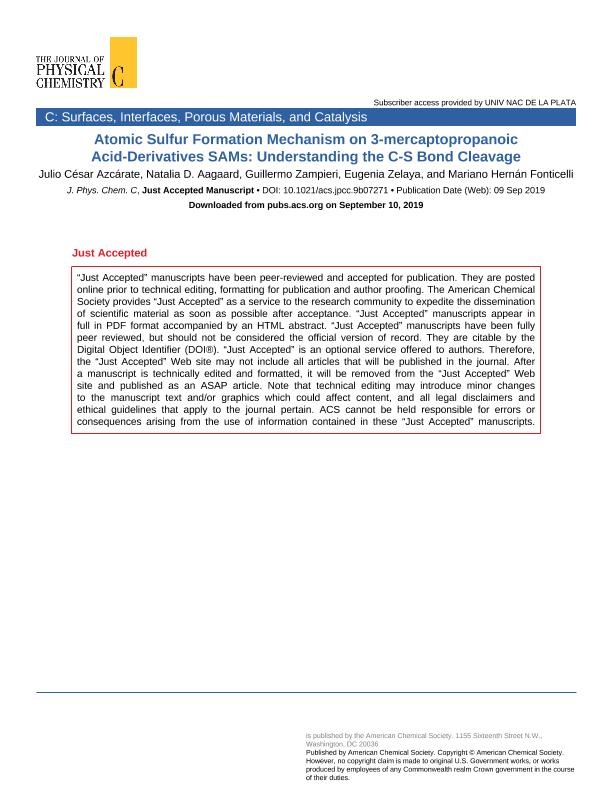Artículo
Atomic Sulfur Formation Mechanism on 3-mercaptopropanoic Acid-Derivatives SAMs: Understanding the C-S Bond Cleavage
Azcárate, Julio César ; Aagaard, Natalia Desiré
; Aagaard, Natalia Desiré ; Zampieri, Guillermo Enrique
; Zampieri, Guillermo Enrique ; Zelaya, Maria Eugenia
; Zelaya, Maria Eugenia ; Fonticelli, Mariano Hernan
; Fonticelli, Mariano Hernan
 ; Aagaard, Natalia Desiré
; Aagaard, Natalia Desiré ; Zampieri, Guillermo Enrique
; Zampieri, Guillermo Enrique ; Zelaya, Maria Eugenia
; Zelaya, Maria Eugenia ; Fonticelli, Mariano Hernan
; Fonticelli, Mariano Hernan
Fecha de publicación:
09/2019
Editorial:
American Chemical Society
Revista:
Journal of Physical Chemistry C
ISSN:
1932-7447
Idioma:
Inglés
Tipo de recurso:
Artículo publicado
Clasificación temática:
Resumen
Self-assembled monolayers (SAMs) of ω-carboxylic acid thiols are very important in the surface modification of metals, especially on gold surfaces. Indeed, the 3-mercaptopropanoic acid (MPA) and its ester or amide derivatives are widely used for SAM-based sensor design. It was already shown that MPA does not suffer C–S bond scission when adsorbed on Au. On the other hand, in this work we demonstrate that its simplest derivative, methyl 3-mercapto propionate (Me-MPA), is prone to form significant amounts of atomic sulfur when adsorbed on Au. The MPA derivatives are more sensible than MPA itself to alkaline solutions, and its SAM-based sensors will rapidly degrade given atomic sulfur. In this work, we study the simplest MPA derivative Me-MPA SAMs on preferentially oriented Au(111) surfaces by XPS and electrochemical measurements. It was found that the desulfuration of Me-MPA depends on its preparation conditions (grown from ethanol or toluene solution) and on its post-treatment with alkaline solution. In order to explain the S–C bond scission on Me-MPA SAMs, we discuss different reaction mechanisms. We concluded that the reaction mechanism involves an E1cB elimination pathway (β-elimination). This reaction mechanism also explains the desulfuration behavior of other important related molecules like l-cysteine and glutathione.
Archivos asociados
Licencia
Identificadores
Colecciones
Articulos(INIFTA)
Articulos de INST.DE INV.FISICOQUIMICAS TEORICAS Y APLIC.
Articulos de INST.DE INV.FISICOQUIMICAS TEORICAS Y APLIC.
Citación
Azcárate, Julio César; Aagaard, Natalia Desiré; Zampieri, Guillermo Enrique; Zelaya, Maria Eugenia; Fonticelli, Mariano Hernan; Atomic Sulfur Formation Mechanism on 3-mercaptopropanoic Acid-Derivatives SAMs: Understanding the C-S Bond Cleavage; American Chemical Society; Journal of Physical Chemistry C; 123; 39; 9-2019; 24156-24164
Compartir
Altmétricas



